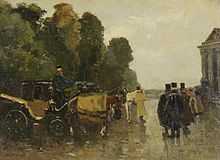Amsterdam Impressionism
Amsterdam Impressionism was an art movement in late 19th-century Holland. It is associated especially with George Hendrik Breitner.
The innovative ideas about painting of the French Impressionists were introduced into the Netherlands by the artists of the Hague School. This new style of painting was also adopted in Amsterdam by the young generation of artists of the late 19th century. Like their French colleagues, these Amsterdam painters put their impressions onto canvas with rapid, visible strokes of the brush. They focused on depicting the everyday life of the city.
Origins
Breitner studied for four-and-a-half years at the Royal Academy, The Hague and came into contact with artists of the Hague School such as Jozef Israëls, Jacob Maris and Anton Mauve, joining the Pulchri Studio. Nevertheless his painting style was always too free to be realist in nature, a hallmark of the Hague School. In 1884 he moved briefly to Paris, coming into contact with impressionism, and on his return he settled in Amsterdam where he became noted for his free and energetic depictions of urban life.[1][2]
Other Amsterdam Impressionists were Floris Hendrik Verster, Isaac Israëls, Willem Bastiaan Tholen, Kees Heynsius, Willem de Zwart, Willem Witsen and Jan Toorop, the last an associate of the Belgian painter James Ensor and a member of the Brussels Les XX. Also included in the movement are a group of late-impressionist woman artists called the Amsterdamse Joffers, whose members included Lizzy Ansingh and Suze Bisschop-Robertson.
Gallery
-

George Hendrik Breitner - The Singel Bridge at the Paleisstraat in Amsterdam, oil on canvas, ca. 1897, Rijksmuseum, Amsterdam.[1]
-

Isaac Israëls - Two models, Epi and Gertie, in the Amsterdam Fashion House Hirsch, oil on panel, ca. 1916, Private collection.
-

Willem Witsen - Warehouses by an Amsterdam canal at the Uilenburg, oil painting, between 1885 and 1922, Rijksmuseum, Amsterdam.[2]
-

Willem Bastiaan Tholen - The Slaughterhouse, oil painting, 1880 - 1901, Rijksmuseum, Amsterdam.[3]
-

Jan Toorop - Women at the Sea, between 1885 and 1897, oil on cardboard, Rijksmuseum, Amsterdam.[4]
-

Willem de Zwart - Carriages with Waiting Coachmen, oil painting, 1890 - 1894, Rijksmuseum, Amsterdam.[5]
-

Floris Verster - View of the Artist's Studio, 1888, watercolor, Stedelijk Museum, Amsterdam.
-

Suze Bisschop-Robertson - Courtyard together with a Work by Johan Buning, oil on panel, before 1922.[6]
- ^ Breitner, George Henrik. "De Singelbrug bij de Paleisstraat te Amsterdam". Rijksmuseum.
- ^ Witsen, Willem. "Pakhuizen aan een Amsterdamse gracht op Uilenburg". Rijksmuseum.
- ^ Tholen, Willem Bastiaan. "The Slaghterhouse". Rijksmuseum.
- ^ Toorop, Jan. "Vrouwen aan Zee". Rijksmuseum.
- ^ de Zwart, Willem. "Rijtuigen met wachtende koetsiers". Rijksmuseum.
- ^ "Lot 75, 6 September 2005". Sotheby's, Amsterdam.